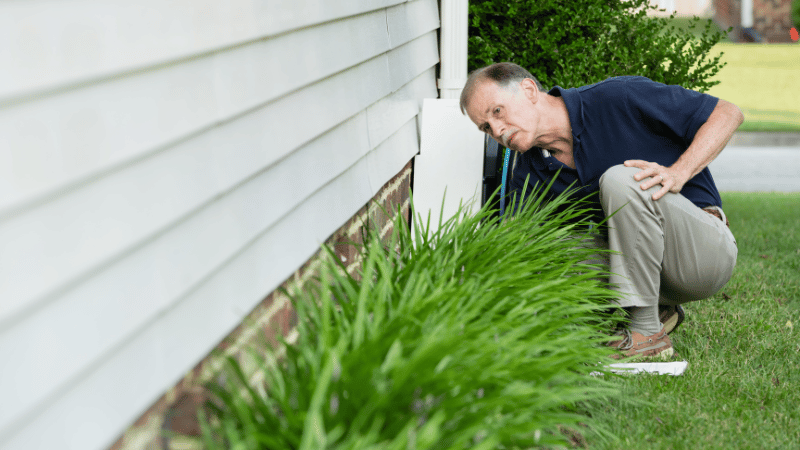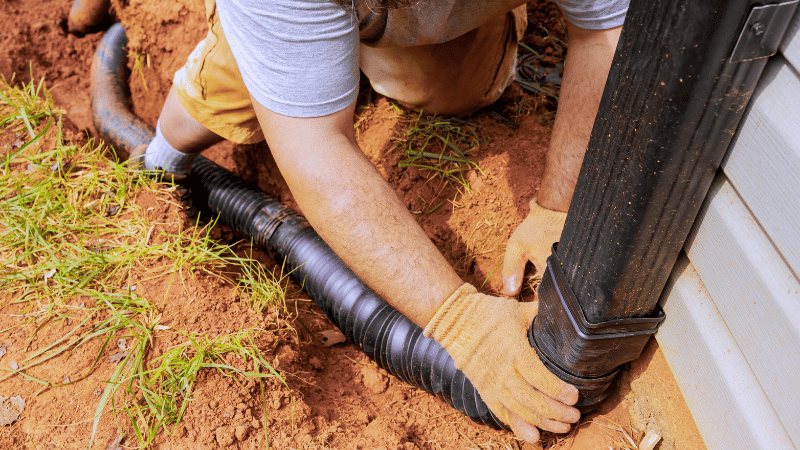aw“Oh no, it’s raining, and this will inevitably seep into my basement, causing potential issues”. As a homeowner, dealing with water damage to your foundation is an experience you never want to face. Whether it’s triggered by a storm, flooding, burst pipes, or any other disaster, it’s a nightmare scenario. Not only is it a major inconvenience, but it can also lead to serious issues such as electrical hazards and mold growth.
While waterproofing serves as your primary defense against basement flooding and is typically installed during the construction of the home, it can also be strengthened and reinforced over time. However, what additional measures can be taken to prevent water from collecting or approaching your foundation every time? Let’s understand the potential reasons behind it.
Table of Contents
Understanding the Causes of Poor Drainage
Poor drainage around your home can arise from various factors like uneven ground, clogged gutters, compacted soil, or insufficient slope away from the foundation. It’s really important to spot these problems early because they can cause serious damage over time, leading to expensive water damage restoration down the line.
Signs of Poor Drainage Around Your Home
To protect yourselves and your house from basement and foundation water damage, pay close attention to these warning signs that are definite RED FLAGS:
- Puddles Everywhere: You know those stubborn puddles that just won’t disappear after it rains? If they’re hanging around long after the storm has passed, it could be a drainage problem.
- Soggy Soil: Does your lawn feel excessively wet, almost like walking on a sponge? If so, it’s a sign that the soil isn’t draining adequately.
- Water Stains: This simply cannot go unnoticed. The water stains on your walls or foundation hint at significant internal water buildup.
- Foundation Fissures: Poor drainage can cause excessive moisture buildup, leading to cracks in the foundation. These cracks can compromise the structural integrity of your home over time.
- Mold Growth: Nobody wants these unwelcome guests! If you start seeing mold or mildew popping up in places like your basement or crawl space, it might be due to excess moisture from poor drainage.
- Gutter Overflow: Clogged or damaged gutters can exacerbate drainage problems. Look for overflowing gutters or water spilling over the sides during rainfall.
- Foul Odors: If your nose is picking up musty or unpleasant odors around your home, it could be because water’s hanging around where it shouldn’t, creating an odor.
- Yard Landscape: Your yard should be like a mini waterpark for rainwater – ideally everything slopes away from your house. If it’s not, water might be pooling where it shouldn’t.
- Erosion: This happens when water isn’t directed away from your home properly, leading to soil washing away from the foundation. You might see patches where the ground looks uneven or washed out.
- Deteriorating Walls: If you notice bulging or flaking within your walls, it could be a sign of water damage. Bulging can happen when water seeps into the foundation and puts pressure on the walls, while flaking paint or plaster might mean moisture is getting in and causing damage.
How to Redirect Water from the Foundation of Your Home?
1. Proper Grading
Proper grading is essential for effectively managing water around your foundation. You want the land to tilt gently away from your house, so rainwater doesn’t pool up and cause trouble.
A good rule of thumb is to aim for about a 5% slope. That means for every 10 feet of ground, it should drop down about 6 inches. This angle helps water flow away smoothly, so it doesn’t hang around your foundation and potentially cause issues like leaks or damage.
2. Installing French Drains
French drains are underground drainage systems designed to redirect water away from specific areas, such as around your home’s foundation. They’re incredibly handy for preventing water buildup that could potentially cause damage.
To set up a French drain, you start by digging a trench around your home. This trench is then lined with landscape fabric to keep out debris and prevent clogs. Next, you lay down a perforated pipe in the trench to allow water to enter. After that, you fill the trench with gravel, providing a path for the water to flow towards the pipe. Once the water gets into the pipe, it’s carried away from the foundation, helping to prevent water buildup and any potential damage.
Installing a French drain can be a smart move to protect your home from the harmful effects of excess water. It’s a practical solution for managing water and keeping your home safe and dry.
3. Gutters and Downspouts
Using gutters and downspouts is a wise way to divert water from your home’s foundation. When rain falls too close to your foundation, it can create problems like water pressure, uneven settling, and erosion. Excess runoff can also contribute to stormwater system issues as the soil becomes saturated. Gutters collect water from the roof and guide it towards the downspouts.
However, many homeowners overlook the proper management of their downspouts. If downspouts simply discharge water near the house, it can accumulate against the foundation, particularly problematic in areas with expanding clay soil. To address this, many homeowners opt for downspout extensions, redirecting runoff to other areas of the property where saturated soil isn’t as much of a concern. While this solution is effective in regions with lower rainfall, it may lead to overflow during heavy rainfalls.
4. Installing Sump Pump Systems
Sump pumps are great additions to homes in areas with high water tables or frequent flooding. They act as reliable barriers against water seeping into basements or crawl spaces.
Here’s how they work: Sump pumps are typically placed in sump pits dug below basement floor levels. When water accumulates in these pits, whether from groundwater or basement drains, the sump pumps activate. They quickly pump out the water, preventing damage to the home’s foundation or interior spaces. One of their significant advantages is their ability to divert water away from homes to safe locations like storm drains or dry wells. This ensures that water doesn’t pose a risk of flooding or seepage.
5. Create Swales and Berms
Swales are essentially shallow ditches or depressions strategically designed to channel water away from specific areas. By creating swales along the perimeter of your property, you can effectively divert water away from your foundation. These swales allow water to flow naturally, reducing the risk of water buildup and potential damage to your home.
On the other hand, berms are raised areas of soil that serve as barriers to redirect water flow. By constructing berms strategically, you can control the path of water runoff, ensuring that it moves away from vulnerable areas like your foundation. Berms can be particularly useful in areas where natural slopes are insufficient for effective water drainage.
Waterproofing Basement
Even if you’ve done everything you can to keep water away from your foundation, it’s still important to waterproof your basement. There are various methods to achieve this. You can apply sealants or waterproof coatings to the interior walls or install a waterproof membrane or drainage system on the exterior. These measures create a barrier against moisture, preventing water from seeping into your basement through cracks or porous surfaces.
Reach Out for Flood & Water Damage Restoration
If your basement has been flooded and suffered significant damage, don’t hesitate to reach out to ServiceMaster by Replacements in Union, NJ. Our experts are equipped to handle basement water damage effectively and immediately. From water extraction to drying out the area and restoring your property, we have the knowledge, experience, and resources to get the job done right.
For all of your disaster restoration needs, contact us at (732) 842-6917 or fill out a form on our website.








